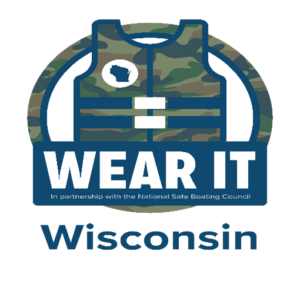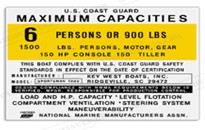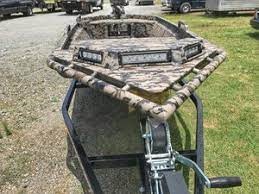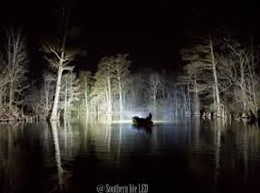An article from WWA’s Words From The Wardens.
This article originally appeared in Wisconsin Waterfowl Association’s September, 2023 eNewsletter.
 By DNR Lt. Warden Darren Kuhn, Boating Law Administrator
By DNR Lt. Warden Darren Kuhn, Boating Law Administrator
Waterfowl season is just about here. I’m sure some of you have been doing your scouting trips, setting up blinds, rigging the boats and perhaps taking a trip or two to the range.
It is an exciting time of year, no doubt about it! It also is the time for waterfowl hunters to review boat safety skills and tips.
Many of the tips and best practices we recommend for the fall waterfowl season are the same as those we emphasize for recreational boaters and anglers in the heat of the summer. However, there are some season-specific practices I see neglected every waterfowl season that rob me of sleep this time of year. I’ve observed too many bad situations that ended well purely because of sheer luck. Don’t leave your safety to chance!
Life Jackets Will Keep You Alive, Waders Will Not
In many cases, hunters hit the water wearing their waders so they are ready to go once they get to their hunting area. While waders are a must for waterfowl hunters, they don’t float and can fill with water, pulling the wearer down. If this happens, there will not be time to get to your life jackets. If you were wearing your life jacket when this situation occurs, the life jacket will do its job. You will be wet and likely cold, but you will be alive.
 Having a life jacket or personal flotation devices (PFDs) for everyone aboard your boat isn’t just a good idea; it’s the law. That means all vessels – including paddle crafts (skiffs, kayaks and canoes) – must have at least one wearable life jacket for each person on board.
Having a life jacket or personal flotation devices (PFDs) for everyone aboard your boat isn’t just a good idea; it’s the law. That means all vessels – including paddle crafts (skiffs, kayaks and canoes) – must have at least one wearable life jacket for each person on board.
These life jackets must be readily accessible. And these jackets must be the proper size and fit for each person aboard.
What does readily accessible mean? The short answer is that someone can quickly access the life jackets in an emergency. It doesn’t mean life jackets tossed in a compartment underneath the decoys, the dog or a blind bag.
I recommend wearing your life jacket. Go above and beyond what the law requires. We all like to think we will remain calm and composed in the face of an emergency on the water, but that’s easier said than done. The last thing you want to be doing in that situation is fumbling through storage compartments trying to recall where you buried the life jackets.
Cold Water Boating
We all know cold weather is one factor that launches the annual waterfowl migration, bringing the ducks south through our favorite flyways. The cold air also cools the water. No more fun in the sun and swimming at the beach. Fall’s chill means it’s time for standing waist-deep in cold water, wondering where the leak in your waders has come from.
The cooler water brings about some excellent hunting but also creates some unique dangers, and extra precautions are necessary to enjoy a safe hunt. Hypothermia can occur within minutes if an emergency happens, and you end up in the water. As the body continues to cool in the cold water, treading water or holding onto your capsized boat will no longer be possible. A life jacket could make all the difference.
As I mentioned earlier, the waders can cause some serious safety issues when they fill up with water, possibly resulting in a drowning situation.
If an emergency happens and you end up in the cold water, hypothermia will set in in a matter of minutes. As the body continues to cool in the cold-water, treading water or holding onto your capsized boat will no longer be possible. A life jacket could make all the difference.
Avoid Overloading Boats
All boats under 20 feet long should have a capacity plate attached somewhere clearly visible to the boat operator. This capacity plate will say how many people can be on board, the weight allowed to be on board and the engine horsepower allowed to be on board the boat.
 If any of these limits are exceeded, you are in violation of the law and putting yourself and others in jeopardy. These limits were established by the boat manufacturer to provide the safety capabilities of the boat. Follow them.
If any of these limits are exceeded, you are in violation of the law and putting yourself and others in jeopardy. These limits were established by the boat manufacturer to provide the safety capabilities of the boat. Follow them.
As hunters, we like to pile stuff in our smaller boats. Keeping track of the capacity of the boat is important.
- How much do the decoys add?
- How about the dog?
- Several boxes of shells, maybe the heater for the blind?
All of this is necessary to consider when loading the boat. If the estimated weight of your gear and passengers exceeds the limit shown on the plate, you must leave some equipment behind. An overloaded boat is less stable on the water, which could result in sinking or capsizing if you encounter rough water.
Check The Weather Before You Go
Most waterfowl hunters check the forecast for sunrise times or to see if rain is coming. When checking conditions before your hunt, remember to check the wind and what weather might be coming later in the day.
This information is easily accessible by watching about five minutes of the local news or installing any of the many available weather apps on your phone.
As hunters, we follow many things, like the moon’s phases and barometric pressure. However, we often forget that to get to our hunting spots, we need a boat and that while bad weather might be good for hunting, it is not good for boating.
Every year, DNR wardens rescue hunters in distress because of weather changes that the hunters didn’t track or believed would blow over.
Check the weather forecast before and during your hunt. Prepare for the conditions you know are coming and those that might be on their way. There isn’t a duck supper worth anyone’s life.
The Problem With LED Light Bars For Duck Boats
 A relatively new trend in the duck-hunting world is the use of LED light bars. These help the operator to see better during dawn and dusk hours of limited light. These lights may violate state and federal boating laws that prohibit using lights that detract from your required navigation lights.
A relatively new trend in the duck-hunting world is the use of LED light bars. These help the operator to see better during dawn and dusk hours of limited light. These lights may violate state and federal boating laws that prohibit using lights that detract from your required navigation lights.
These LED light bars are so bright that other boat traffic can only see the white light and not the boat’s red and green navigation lights. This is a safety problem.
 The red and green navigation lights along with the standard 360-degree white light indicate which direction a boat is heading, and which boat has the right-of-way in each situation. Taking away other boaters’ ability to see these red/green navigation lights creates an unsafe situation for everyone on the water, including the boater with the LEDs.
The red and green navigation lights along with the standard 360-degree white light indicate which direction a boat is heading, and which boat has the right-of-way in each situation. Taking away other boaters’ ability to see these red/green navigation lights creates an unsafe situation for everyone on the water, including the boater with the LEDs.
Hunters need to remember that navigation lights on boats are not intended for the boat operator to see better at night but rather to notify other boaters of the direction they are traveling.
When boaters are blinded by the LED light bars on other vessels, this is no different than encountering a car on the highway with their high beams on. If you are new to an area and not familiar with all the curves, sloughs and channels, adding extra lights isn’t the answer. Slowing down or spending more time scouting is.
LED lights should be left off as you navigate to and from your hunting spots. Once you get to your spot, you can use them for extra light as you set your blind. In short, when underway, leave the light bars off.
Hunters should also be mindful that paddle craft are only required to carry a white light to avoid night collisions. If you are hunting in a spot frequented by skiffs and kayaks, navigate slowly and be alert for small craft.
I hope this pre-season preparation advice helps you prepare for an enjoyable season. In closing, please always wear your life jackets and enjoy a safe hunt.
